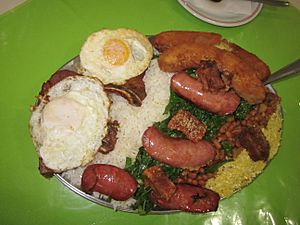Virado facts for kids

Virado à Paulista
|
|
| Type | Platter |
|---|---|
| Place of origin | Brazil |
| Main ingredients | beans, pork, manioc flour, fried sausage; breaded and fried plantain, eggs, kale, rice, torresmo (a crisply cooked pork rind) |
Virado, also called virado à Paulista, is a full meal from the state of São Paulo, Brazil. This dish has been around since the first Portuguese settlers arrived in the area.
A plate of Virado usually has beans cooked with onion, garlic, and salt. It also includes toasted manioc flour, a pork chop, and fried sausage. You'll find breaded and fried plantain, eggs (often with soft yolks), and kale cooked in fat. Rice and torresmo (crispy pork rind) complete the meal. People traditionally eat Virado on Mondays. About 500,000 plates of this dish are served every week in the city of São Paulo alone!
How Virado Began
Virado became popular during the early colonial period in Brazil. It was a common meal for the bandeirantes, who were explorers and adventurers. These bandeirantes traveled deep into Brazil's lands. They were looking for gold, silver, and diamonds.
They carried beans, pork, and corn flour in their backpacks. As they traveled, these ingredients would "turn" or mix together in their bags. The Portuguese word for "turn" is virar, which is how the dish got its name, "virado."
Back then, Virado was simpler. It had beans (often cooked without salt), corn flour, dried meat, and bacon. Later, in the 1700s, manioc flour replaced corn flour in São Paulo. The bandeirantes and early settlers ate Virado cold or warmed up.
The first time Virado was written about was in 1602. This was when Nicolau Barreto went on an expedition to what is now Paraguay, Bolivia, and Peru. The dish is also linked to the monção, who led river expeditions into Brazil's remote areas from the 1700s to the early 1800s.
Virado in Homes
Virado became a main meal in homes and farms in the São Paulo region. Homes in São Paulo during the early colonial period were simple. They were not as fancy as those in Bahia, Pernambuco, or Rio de Janeiro.
Virado was eaten at all times of the day. Back then, it included beans, bacon, flour, a piece of pork, smoked linguiça (a type of sausage), and kale.
Rice was added to Virado in the 1800s. This was after rice farming became widespread in Brazil. The rice was cooked with leftover pork or sausage drippings. It was also flavored with lard, garlic, and salt. For dessert, people often ate fresh fruit like oranges. Bananas fried with cinnamon and sugar were also a common treat.
Even important people enjoyed Virado. Dom Pedro I, who was the first Emperor of Brazil, ate Virado on August 17, 1822. He had it at Fazenda Pau d'Alho, in São José do Barreiro, during his trip from Rio de Janeiro to São Paulo.
Different Ways to Make Virado
There are a few different ways to make Virado. The main parts usually stay the same: pork, fried banana, beans mixed with cassava flour, rice, kale, and a fried egg. Sometimes, Virado is made with black beans and corn flour instead.
An early version of the dish appeared when the bandeirantes explored Minas Gerais. There, it became known as tutu à mineira. The main difference is that tutu à mineira uses mashed beans, while the São Paulo version of Virado uses whole beans. In the state of Santa Catarina, some people make a version that uses cooked cabbage instead of kale.

